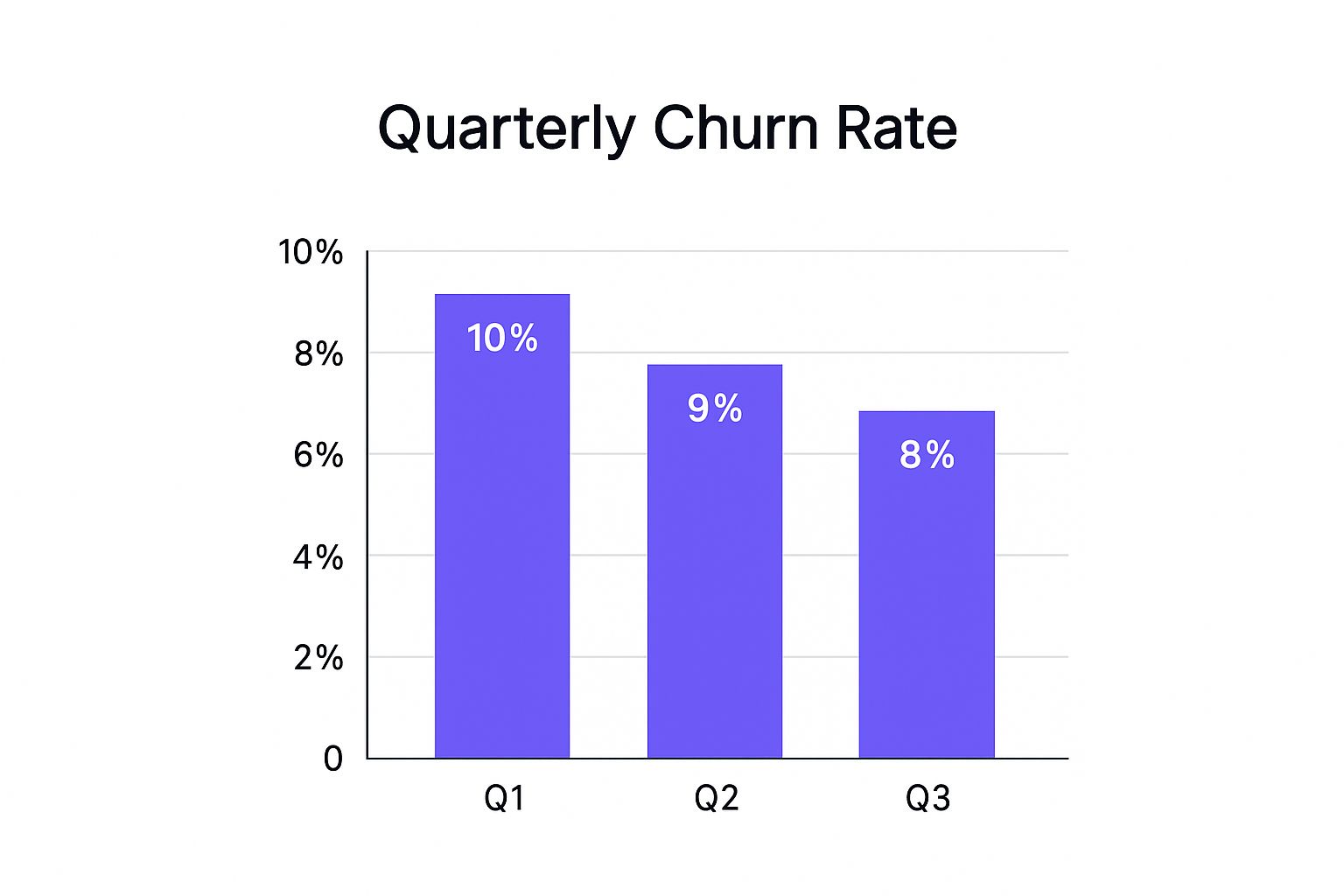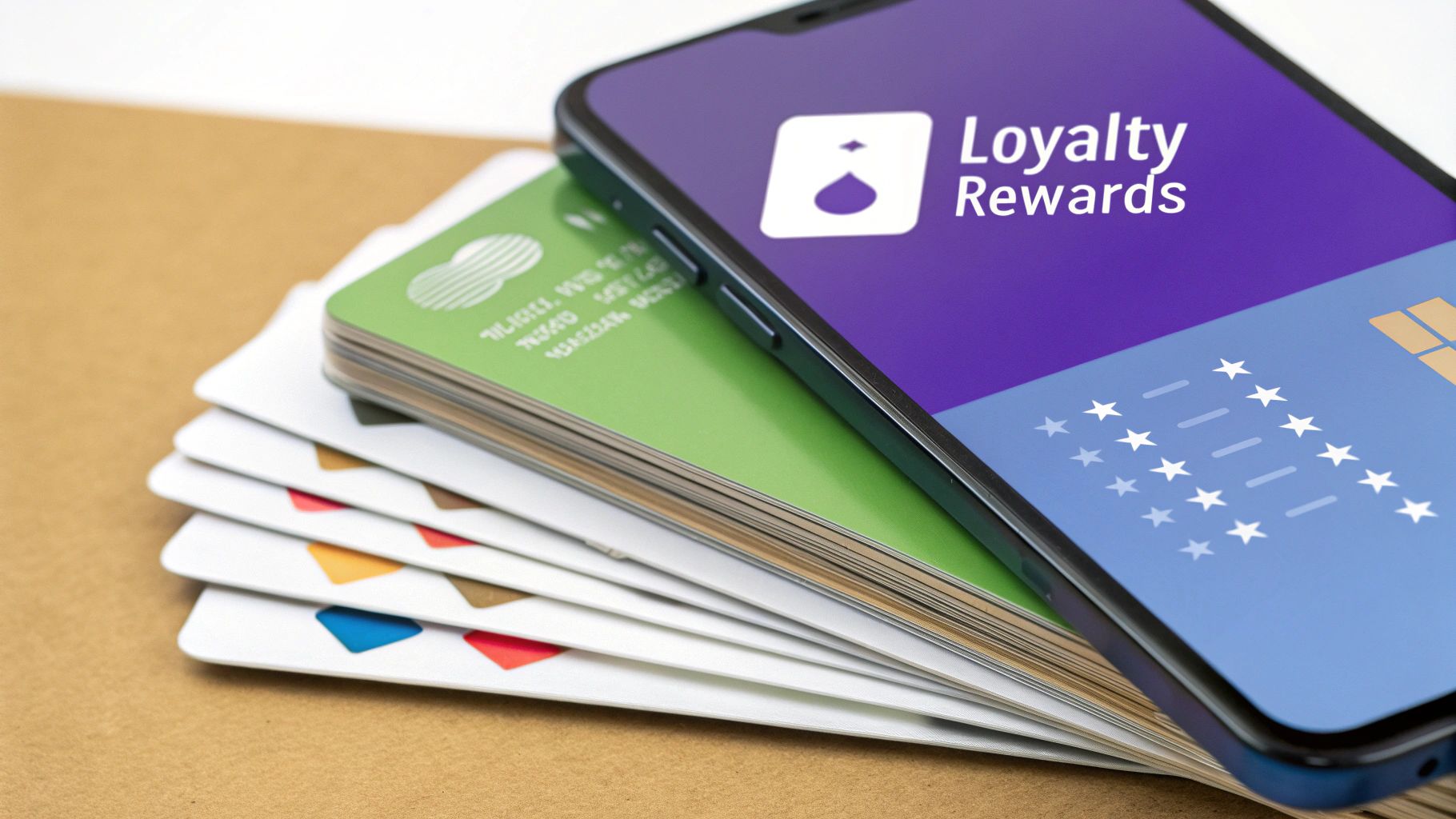
To really get a handle on reducing customer churn, you first have to face its true financial impact. It's way more than just a percentage on a report. The goal is to move from putting out fires to building a proactive system that tackles both voluntary churn (when customers actively decide to leave) and involuntary churn (the accidental kind, like when a payment fails).
Before you can patch a leaky bucket, you need to know just how fast the water is draining. Customer churn isn't some background metric to glance at; it’s a silent killer of your revenue and growth. I've seen too many businesses write off a "small" monthly churn rate as just the cost of doing business, but its corrosive effect adds up fast.
The financial drain from churn hits you in two ways. First, there's the obvious loss of recurring revenue from the customer who just walked away. But the second, and often more damaging cost, is the resources you have to divert from innovation and growth just to keep refilling your customer pipeline.
Every dollar and every hour your team spends replacing a lost customer is a dollar and an hour you didn't spend making your product better or exploring new markets. It's a constant drag on momentum.
One of the first things you learn in the retention game is that not all churn is the same. Understanding the difference is critical to building a strategy that actually works.
Voluntary Churn: This is what most people think of—a customer makes a conscious choice to cancel. Maybe they were unhappy with the service, found a better deal from a competitor, or had to tighten their budget. To fight this, you have to take a hard look at your customer experience and the value you're delivering.
Involuntary Churn: This is the "accidental" churn. It happens when a customer who likely wants to stay gets dropped, usually because of a payment failure. An expired credit card, a bank decline, or insufficient funds are common culprits. The good news? This is often the low-hanging fruit you can fix with the right automated tools.
This chart shows a simplified, ideal scenario where a company gets its churn rate trending down over time with a focused effort.

While the graph shows a positive trend, the real danger is what happens when you don't take action. The compounding effect of even small monthly losses is staggering.
A seemingly modest churn rate of 5% per month doesn't sound too bad, right? But it compounds. As the table below shows, that seemingly small number can wipe out a huge portion of your customer base over the course of a year.
This table illustrates how a small monthly churn rate can lead to significant annual customer loss, demonstrating the compounding effect over a year.
As you can see, that 5% monthly churn results in losing nearly 46% of your customers by the end of the year. Analysis of millions of subscriptions confirms this; without active management, almost half a company’s customer base can disappear in just 12 months.
Once you grasp this compounding disaster, the financial urgency becomes crystal clear. A high churn rate puts your business on a hamster wheel of expensive customer acquisition. We all know the stats: acquiring a new customer costs 5 to 25 times more than keeping an existing one.
The real cost of churn isn't just lost revenue; it's lost momentum. It's the anchor that holds your company back from reaching its true potential.
By looking past simple dashboard metrics, you can start to see churn for the fundamental threat it is. For a deeper look, there are many proven strategies for preventing customer churn that explore these hidden costs in more detail. The goal is to reframe retention not as a defensive chore but as one of the most powerful growth engines you have.
You can't fix a problem you don't fully understand. If you’re serious about reducing customer churn, you have to move past guesswork and hunches. It's time to put on your detective hat and start using data to pinpoint exactly why your customers are walking out the door.

First off, let's get one thing straight: churn is rarely caused by a single, dramatic event. It’s usually a slow burn—a series of small frustrations and unmet expectations that finally reach a tipping point. A customer might check the "pricing" box on their exit survey, but the real story could be that they never figured out how to use your product effectively and, as a result, couldn't justify the cost.
Your goal is to uncover these deeper root causes by weaving different types of data into one coherent story.
To get the full picture, you need to look at both what your customers do and what they say. Focusing on just one gives you a dangerously incomplete view.
Quantitative Data (The "What"): This is the hard evidence living in your product analytics. Think login frequency, feature adoption rates, time spent in the app, and the number of support tickets they've filed. This data shows you the behavioral patterns that often signal a customer is quietly drifting away.
Qualitative Data (The "Why"): This is where you get the human context behind the numbers. You’ll find this gold in exit surveys, customer interviews, online reviews, and even by analyzing the sentiment of support chats. This is where customers vent about a clunky user interface, complain about your pricing model, or rave about a competitor’s new feature.
The real breakthrough comes when you connect these two streams. For instance, your quantitative data might flag that a customer stopped using a key feature two months ago. Then, in an exit survey, they mention that the feature was too confusing without a good tutorial. Bingo. Now you have a clear, actionable problem to solve: improve the onboarding for that feature.
With a richer, combined dataset, you can start to spot the recurring themes—the primary reasons customers are leaving. These drivers often fall into a few common buckets. I’ve found that creating a simple diagnostic table is a fantastic way to organize these findings and make them actionable.
Let’s imagine a B2B software company. After digging in, their churn analysis might look something like this:
This exercise turns vague anxieties about churn into a concrete to-do list. From there, you can prioritize which issues to tackle first based on how often they come up and their overall impact on revenue.
It’s also crucial to see how you stack up against others in your field. Average churn rates vary wildly by industry. For example, financial services often have a strong median customer retention rate of 81% (a 19% churn rate), while the wholesale sector can see churn as high as 56%. This is often due to low switching costs and supply chain dynamics. Knowing your industry's benchmarks helps you set realistic goals. You can find a complete overview of churn rates by industry to see where you stand.
The goal isn't just to collect data; it's to connect the dots. A drop in logins is a data point. A customer telling you your UI is clunky is a data point. Connecting them is an insight that drives action.
By systematically diagnosing the real reasons for churn, you empower your team to build targeted, effective retention strategies. You can finally stop throwing generic discounts at the problem and start solving the specific issues that are pushing your valuable customers away. This evidence-based approach is the bedrock of any sustainable churn reduction effort.

The best way to slash your churn rate? Stop churn before it even has a chance to start. This isn’t just about a new tool; it's a fundamental shift in your company’s mindset. You have to move from being reactive firefighters to proactive problem-solvers. Forget waiting for the cancellation email to land in your inbox. The goal is to build an early-warning system that flags at-risk customers while you still have plenty of time to step in and help.
This entire proactive engine is fueled by the data you're already sitting on. By connecting the dots between user behavior, support interactions, and even billing information, you start to see a living, breathing picture of each customer's health.
Your first move is to figure out the digital red flags—the subtle signs that a customer is quietly drifting away. These behaviors are almost always there, happening long before a customer consciously decides to leave.
Think about it from your own product’s perspective. What do your power users do every day? Now, what about the users who are losing interest? It's usually a combination of things they do and, more importantly, things they stop doing.
Here are some of the most common at-risk indicators I see time and again:
With a platform like Statisfy, you can create automated alerts for these kinds of behavioral triggers. The system basically becomes your lookout, freeing up your Customer Success team to do what they do best: actually engaging with customers, not getting lost in dashboards.
An unengaged customer is an invisible risk. They won't complain or file support tickets; they will simply disappear when their subscription is up for renewal. Proactive monitoring is the only way to find them.
Once you’ve spotted a customer who's showing signs of trouble, you need to reach out. But a generic "Just checking in!" email is worse than useless; it’s annoying. Your outreach has to be personal and directly tied to the specific behavior you've noticed.
This is where smart automation becomes your secret weapon. You can design helpful, targeted interventions that trigger automatically based on what a customer does (or doesn't do). This isn't about spamming them—it’s about delivering the right help at exactly the right moment.
Let’s walk through a real-world scenario:Statisfy’s AI detects that a customer, "Acme Corp," has a dipping health score. It pinpoints the reason: they haven’t adopted a crucial reporting feature that other, similar customers use to prove ROI.
Instead of just sending a generic alert to your team, the system can trigger a specific, automated action. An email goes out to the main contact at Acme Corp with a subject line like, "A quick tip for your Q3 reports." The email includes a 90-second tutorial video showing them exactly how to use the feature they've been ignoring.
This approach works on multiple levels:
If you're looking for more ideas, check out these proven strategies to reduce customer churn that go deeper into proactive techniques.
A massive driver of early-stage churn is a weak onboarding experience. It's simple: if new customers don't quickly grasp how your product solves their problem—that "aha!" moment—they'll lose interest and just fade away. A well-structured onboarding process isn't just nice to have; it's a non-negotiable part of any proactive retention engine.
Your one and only goal here is to guide every new user to experience the core value of your product as fast as humanly possible. This means ditching the one-size-fits-all product tour.
Instead, use data to personalize their first few interactions. Based on a user's role or what they say their goals are, you can show them the specific features that matter most to them. Use a mix of in-app guides, simple checklists, and triggered emails to create a clear path that leads them from setup to their first big win. When you fast-track their journey to value, you dramatically improve the odds they'll stick around for the long haul.

Sometimes, a customer leaves for reasons that have nothing to do with your product's features or price. It often boils down to the experience. Every interaction—from a quick support chat to an unexpected email—adds up, building the emotional connection that turns a subscriber into a true advocate for your brand.
A single bad interaction can poison the well, erasing months of hard-earned goodwill. And the financial fallout is massive. In the U.S. alone, companies lose an estimated $136.8 billion each year from churn they could have prevented.
Consider this: studies show 17% of American customers will walk away from a brand after just one negative experience. That number skyrockets to 59% after several. This just goes to show that improving the customer experience is a direct line to lower churn—by as much as 15%, according to some research.
Every touchpoint is more than a transaction. It’s a chance to prove your value and strengthen the relationship.
Your support team is on the front line of customer retention. They hold the power to transform a moment of pure frustration into one of genuine loyalty. The secret is to shift their role from agents reading scripts to empowered problem-solvers.
When a customer contacts you with an issue, they aren't hoping for a canned response from a policy manual. They want to connect with a human who gets their situation and has the flexibility to find a real solution. Empowering your team means giving them the authority to make things right, whether that's offering a small service credit, extending a trial, or just spending extra time walking a user through a tricky process.
This shift hinges on two key ingredients:
When an agent can say, "I understand that's frustrating, and while our policy is X, here is what I can do for you right now," they don't just solve a problem. They create a memorable, positive experience that forges a powerful emotional bond with your brand.
The most loyal customers aren't the ones who never had a problem. They're the ones who had a problem that you solved brilliantly.
While fixing problems is absolutely critical, building loyalty also happens in the quiet moments between issues. Small, unexpected gestures can have a surprisingly big impact on how customers feel about your company. These are the moments that show you see them as more than just a number on a revenue report.
Think beyond the automated birthday emails. Real connection comes from personalized, timely outreach that proves you're paying attention.
Here’s a real-world scenario:
Let's say your system, powered by Statisfy's AI, flags that a user has been logging in late at night all week, clearly pushing to meet a deadline. This could trigger an alert for their Customer Success Manager (CSM). The CSM could then send a simple, personal email:
"Hi Alex, I noticed you've been burning the midnight oil in our platform this week. Hope you're crushing that big project. Just wanted to say we see the hard work—let us know if there's anything we can do to help you get it across the finish line."
This isn't a sales pitch. It's not an upsell. It's a simple act of recognition that makes the customer feel seen and valued. This level of personalization is a cornerstone of modern retention. To truly drive loyalty, you need to explore powerful customer engagement strategies that build these lasting relationships. Every positive interaction is another customer you keep.

If you're serious about cutting down customer churn, you need to understand one thing: it’s not a one-and-done project. There's no finish line. Real success comes from building a continuous cycle of listening, acting, and improving. It's about creating a robust feedback loop that systematically captures what your customers are thinking and feeling, then turning those insights into actual product and service enhancements.
This goes way beyond sending out an annual survey. I'm talking about a system that's always on, constantly gathering intelligence from every touchpoint. Think NPS surveys, online reviews, support chats, and even those off-hand comments a customer makes on a sales call. The hard part isn't just getting all this data; it's organizing it so it actually gets to the people who can do something about it.
This is where a platform like Statisfy can be a game-changer. Its AI can sift through a support ticket, instantly analyze the sentiment, and tag it with something useful like "feature_request" or "UI_frustration." Then, it automatically routes that feedback right into the backlog of the correct product or engineering team. You’re essentially turning a messy, chaotic stream of opinions into an organized, actionable resource.
To make any feedback truly actionable, you have to capture it consistently. If you only listen to the loudest or most persistent customers, you’re getting a warped view of reality. A systematic approach is the only way to get a balanced perspective from your entire user base.
Your collection strategy needs to be a mix of methods, pulling insights from different points in the customer journey.
By pulling all this data together, you can start to see patterns instead of just putting out individual fires. For instance, if you notice that 15% of your support tickets last month mentioned problems with a specific workflow, you’ve just found a high-impact area begging for improvement.
Collecting and analyzing feedback is only half the job. The most crucial part—and the one most companies totally drop the ball on—is closing the loop. This means getting back to your customers to let them know you not only heard them but that you actually did something about their feedback.
This simple act transforms customers from passive users into genuine partners. It’s definitive proof that you’re listening, which makes them feel invested in where your product is headed. When you act on feedback, you build a level of goodwill and loyalty that no feature or price point can ever match.
Acknowledging customer feedback is good. Acting on it is better. But closing the loop by communicating that action back to them is what builds unshakable loyalty.
Let's play out a real-world scenario. A user submits a feature request for a specific integration. Six months go by, and you finally launch it. Instead of just a generic company-wide announcement, imagine sending a targeted email to that user—and everyone else who asked for it.
A simple message like, "Hi Sarah, a while back you asked for a Salesforce integration. We listened, and it's here! Thanks for helping us make the product better," is incredibly powerful. You’ve just validated their input and shown them that their voice actually matters. That one small gesture can stop future churn in its tracks by making the customer feel like an integral part of your journey. It reinforces their decision to choose you and makes them far less likely to ever look for an alternative.
Even with the best retention plan, you're bound to run into some specific questions once you get into the weeds. I've been there. Here are some quick, practical answers to the most common questions that pop up when you're working to reduce customer churn.
Honestly, there's no magic number. A "good" churn rate is completely relative to your industry, business model (B2B vs. B2C), and how long you've been around. Context is king here.
For a young B2B SaaS company just getting its sea legs, a 3-5% monthly churn rate might be perfectly normal. But for a more established business serving enterprise clients, you’d want to see that number well under 2% monthly.
Don't get too hung up on universal benchmarks. Your most powerful goal is to create a downward trend. Focus on consistently lowering your own churn rate quarter after quarter. It’s useful to know your industry's average—for instance, the 19% annual churn in financial services is a world away from the potential 56% in wholesale—but your real mission is to outperform your past self and become a leader in your own space.
Predicting churn is all about learning to spot the warning signs. Think of them as behavioral red flags that almost always pop up before a customer actually hits the cancel button. If you can track these signals, you can step in while there's still time to make a difference.
Keep an eye out for these classic tells:
The trick is to set up automated alerts for these behaviors. That way, you can create a proactive outreach system and start a conversation before they've already decided to walk away.
Understanding this distinction is critical because they have completely different causes and, therefore, require completely different fixes.
Voluntary churn is when a customer actively decides to leave. Maybe they're unhappy with the product, found a better deal, had a bad service experience, or their budget was cut. Fighting this type of churn is all about proving value, improving their experience, and building a real relationship.
Involuntary churn is when a customer leaves by accident. This is almost always a technical issue, like a failed payment because a credit card expired, there were insufficient funds, or the bank just declined the charge. While voluntary churn needs a human touch, involuntary churn can often be solved with smart automation.
You can't solve an involuntary churn problem with a better user experience, and you can't solve a voluntary churn problem with a new credit card form. Knowing the difference is the first step to allocating your resources correctly.
This is a tricky one. Discounts can be a double-edged sword. Sure, offering a price cut might stop a customer from canceling right now, but it's often a short-term fix that can cheapen your product in the long run. If you rely on them too much, you’ll just end up with customers who are loyal to the discount, not to you.
The smarter play is to use discounts surgically, usually as a last resort.
Before you even think about offering a discount, you have to diagnose the real problem.
Your energy is almost always better spent on reinforcing your product's value, solving the customer's actual problem, and making their experience better. That's what builds real, lasting loyalty—something a simple price cut can never buy.
Ready to turn these insights into action? Statisfy uses AI to automate churn detection, deliver proactive recommendations, and empower your team to build stronger customer relationships. Stop churn before it starts by visiting the Statisfy website.